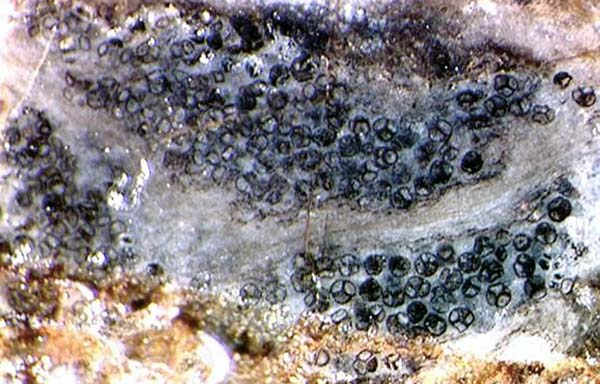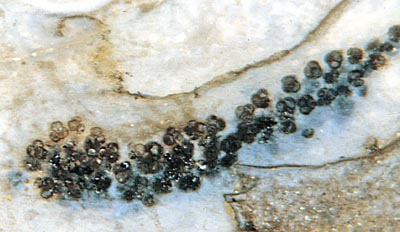Horneophyton
spores differently arranged
It is a characteristic feature of land plants that their spores are
produced in tetrads. Such spore tetrads are surprisingly well seen in
not quite mature sporangia of the Lower Devonian plant Horneophyton
preserved in the Rhynie chert, as in Figs.1-3. (For higher magnified
spores and tetrads see [1] but do not take the schematic
sporangium
model for real.)


Fig.1 (far left):
Horneophyton
sporangium with columella forking at an obtuse angle, wall
decayed but spores kept together, tetrads mainly intact on the right
and disintegrated on the left. Photograph: H. Sahm.
Fig.2 (left): Horneophyton
sporangium, cross-section near the base where the prongs of the
columella are not yet separated, wall well preserved, spore tetrads
mainly intact, some disintegrated. Width of the section 2.8mm.
Fig.3
(below): Narrow lobe of a Horneophyton
sporangium with spores mainly in tetrads.

The
above figures offer the usual aspect of Horneophyton spores
which had
not yet been scattered before silicification. A quite different aspect
is provided by another sample (Fig.4), where a sporangium with
enigmatic content is seen near a normal one with mature spores.

Fig.4 (left):
Three Horneophyton
sporangia (or sporangium lobes) with different
content: spore tetrads mostly disintegrated into individual mature
spores (above left), small grains of unequal sizes rather unlike
spores (below), two tiny grains and a columella section, faintly seen
(small empty
sporangium lobe near the margin on the right).
The starkly
differing sizes of the cell-like grains in Fig.4 (below) suggest the
idea of sporogenic tissue at some early stage of spore formation but
the apparently strong wall of the grains seems to contradict this. As
another peculiarity, there is a tendency of the grains of any size to
arrange in chains. Apparently all this does not make sense. Perhaps it
is a
case of spore production gone awry. Spores are produced in a complex
process called meiosis, involving two successive cell
divisions of different type
which make four haploid cells from one diploid cell.
Could a
substance released by one of the omnipresent fungi in the Rhynie chert
biotope have interfered with the system controlling spore production ?
H.-J.
Weiss
2011
[1] D.A.
Eggert : The sporangium of Horneophyton lignieri.
Amer. J. Bot. 61(1974), 405-413.
 |
 |
45 |







